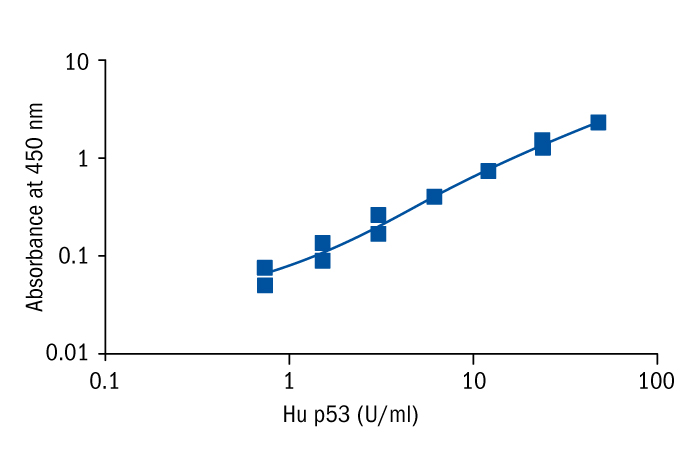Type
Sandwich ELISA, Biotin-labelled antibody
Applications
Serum, Cell culture supernatant
Sample Requirements
50 µl/well
Shipping
At ambient temperature. Upon receipt, store the product at the temperature recommended below.
Storage/Expiration
Store the complete kit at 2–8°C. Under these conditions, the kit is stable until the expiration date (see label on the box).
Calibration Curve
Calibration Range
0.78–50 U/ml
Limit of Detection
0.33 U/ml
Intra-assay (Within-Run)
CV = 5.5%
Inter-assay (Run-to-Run)
CV = 8.9%
Spiking Recovery
95,00%
Dilution Linearity
102,00%
Research topic
Oncology
Summary
p53 is the most commonly mutated gene in human cancer. Mutations and allele loss in the gene located on chromosome 17p are the most frequent alterations yet identified in human malignancies. The p53 protein is highly conserved the evolution and expressed in most normal tissues. Wild-type p53 has been shown to be a sequence-specific transcription factor, directly interacting with various cellular and viral proteins.
p53 is considered a stress response gene, the p53 protein acts to induce cell cycle arrest or apoptosis in response to DNA damage, thereby maintaining genetic stability in the organism. These functions are executed by a complex and incompletely understood series of steps known as the p53 pathway.
Initially described as an oncogene, p53 was shown to be capable of suppressing the proliferation of transformed cells. Studies furthermore demonstrated that intact p53 function is essential for the maintenance of the non-tumorgenic phenotype of cells Thus p53 plays a vital role is suppressing the development of cancer.
p53 is a tumor suppressor gene which induces apoptosis. An inverse relationship in some neoplasms has been shown between p53 and Bcl-2, a proto-oncogene inhibiting apoptosis. The Bcl-2 homologue BAX gene has also been characterized to be regulated by p53; BAX acts to accelerate the rate at which apoptosis proceeds. p53 was further shown to mediated apoptosis through cell surface trafficking of APO-1/Fas.
p53 as a transcription factor induces the expression of p21WAF1/CIP1/Sdi1 leading to G1 arrest of the cell. p53 is known to be regulated by phosphorylation by a number of specific protein kinases. Activation by autoproteolysis has been shown. In addition to proliferation control, a role for p53 is cell senescence has been describe. More than 500 mutations in the p53 gene have been described. These mutations were found
in various types of malignancies, hematologic as well as solid tumors. However, all the mutants are not necessarily equivalent in terms of biological activity.
The mutational spectrum differs among cancers of the colon, lung, esophagus, breast, liver brain, skin, and hemopoietic tissues. The chemotherapy-supported p53 gene therapy is under clinical investigation.
Find documents for the lot
Example Instructions for Use (RUO)
Example Instructions for Use (RUO)
Safety Information (RUO)
MSDS (RUO)

